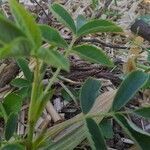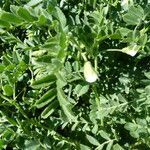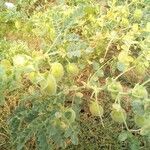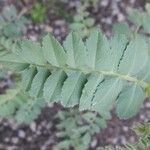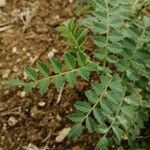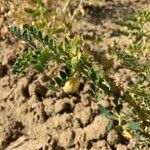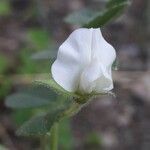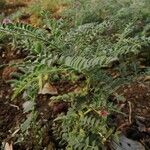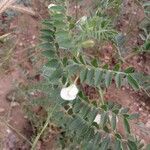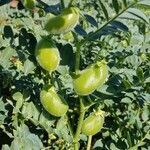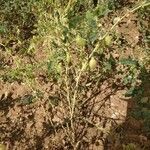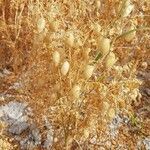An annual legume herb. Plants are 40-60 cm high and all parts are hairy. It is erect with many branches. Plants are often bluish green in colour. Plants have a strong taproot. The root carries many nodules. The leaves are 5 cm long. It has leaves made up of 9-15 pairs of leaflets along a stalk and a single leaflet at the end. The leaflets are 1-2 cm long by 0.3-1.4 cm wide and strongly pointed and with a saw toothed edge. The flowers can be white, pink or purple. The flowers are carried singly on long stalks in the axils of leaves. The flowers normally never open and are self pollinated. The pods are inflated. Pods are 2-3 cm long and have 1 or 2 seeds. The seeds are angular and up to 1 cm across. They have a pointed beak. The seed colour can vary from brown, white, red or black. There are many named cultivated varieties.
Herbs annual, 12-80 cm tall. Stem much branched, erect, glandular hairy. Leaves imparipinnate with a terminal leaflet; stipules leaflike, unequal, margin toothed; leaflets 3-8-paired, elliptic, 7-17 × 3-10 mm, glandular hairy, margin dentate at least in distal half. Raceme 1-or 2-flowered; pedicels 5-25 mm. Calyx campanulate, deeply toothed, glandular hairy. Corolla white, light blue, or purple-red, 8-10 mm, glandular hairy. Legume pendulous, inflated, ovate in outline, (1.5-)2-3.5 × 1-1.7 cm, 1-4-seeded, pubescent and glandular hairy. Seeds 5-15 × 5-10 mm. Fl. Jun-Jul, fr. Aug-Sep. 2n = 16.
Corolla white, or pinkish to purplish, the standard darker; standard 8–10 × 7–10 mm, obovate, glabrous or loosely eglandular pubescent; wings 6–9 × c. 4 mm, obovate, obtuse, asymmetrical at the base, auriculate, the auricle c. 1 mm long; keel 6–8 mm long, the petals adnate for two-thirds of the frontal side of the ventral margin and with a 2–3 mm long claw.
Leaves imparipinnate, with (3)5–7(8) pairs of leaflets; leaflets subsessile, 7–19 × 3–10 mm, elliptic, mucronate or aristate, cuneate at the base, with the upper two-thirds of the margins conspicuously dentate, glandular pubescent above and beneath; rhachis 25–60 mm long, grooved above; stipules 3–5 × 2–4 mm, ovate to triangular, 2–4-fid.
Seeds 1–2(4), 7–10 × 5–8 mm, subglobose or oblong-obovoid, with a median groove and a curved beak overhanging the hilum, whitish, yellowish or pale brownish, surface smooth, wrinkled or tuberculate.
Flowers solitary, axillary; peduncle 0.7–2(3) cm long, ending in a small arista 0.2–4 mm long; pedicels 5–12 mm long, recurved in fruit; bracts up to 3 mm long, linear to triangular.
Stamens 9, united into a sheath 4–5 mm long, free above for 2–3 mm, and 1 stamen free from the base; anthers basi-dorsifixed.
Calyx tube 3–4 mm long, dorsally gibbous at the base; teeth 4–5 mm long, lanceolate, with prominent midribs.
Ovary 2–3 × 1–1.5 mm, ovate, 1–2(4)-ovulate; style 3–4 mm long; stigma widened after pollination.
Pod 20–35 × 10–20 mm, elongate-ellipsoid, inflated, densely glandular pubescent.
Erect or prostrate annual herb, pubescent on all parts except the corolla.
Stems simple or branched from the base, up to 1 m high.
